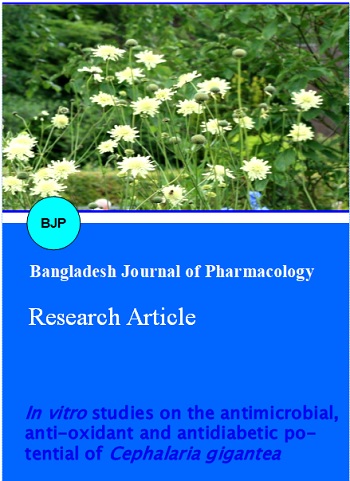In vitro studies on the antimicrobial, antioxidant and antidiabetic potential of Cephalaria gigantea
DOI:
https://doi.org/10.3329/bjp.v10i1.21716Keywords:
?-Amylase, Antimicrobial, Anti-oxidant, Cephalaria gigantean, ?-GlucosidaseAbstract
This study evaluates the antimicrobial, antioxidant and antidiabetic potential of leaf and root extracts of Cephalaria gigantea. The results showed that the extracts inhibited both bacteria and fungi tested at MIC values which ranged from 3.1 to 12.5 mg/mL. The root water and leaf hydro-ethanol extracts had the highest content of phenolics exhibiting IC50 values of 310.9 mg/g and 275.2 mg/g respectively. The leaf water extract possessed the highest amount of flavonoids with IC50 value of 145.4 mg/g followed by root hydro-ethanol extract with IC50 value of 53.4 mg/g. The leaf and root water extracts had the best DPPH radical scavenging activity with IC50 values of 0.6 µg/mL and 2.8 µg/mL compared to gallic acid at 14.0 µg/mL. The leaf hydro-ethanol and root water extracts scavenged ABTS radical best. Also the leaf and root hydro-ethanol extract exhibited the best reducing power activity when compared to gallic acid. The root water and leaf ethanol extracts displayed the most potent inhibition of ?-amylase and ?-glucosidase respectively. It can be concluded that C. gigantea extracts possessed antioxidant and antidiabetic potentials but has poor antimicrobial activities.
Downloads
1661
366 Read
235

Published
How to Cite
Issue
Section
License
Authors who publish with this journal agree to the following terms:
- Authors retain copyright and grant the journal right of first publication with the work simultaneously licensed under a Creative Commons Attribution License that allows others to share the work with an acknowledgement of the work's authorship and initial publication in this journal.
- Authors are able to enter into separate, additional contractual arrangements for the non-exclusive distribution of the journal's published version of the work (e.g., post it to an institutional repository or publish it in a book), with an acknowledgement of its initial publication in this journal.
- Authors are permitted and encouraged to post their work online (e.g., in institutional repositories or on their website) prior to and during the submission process, as it can lead to productive exchanges, as well as earlier and greater citation of published work (See The Effect of Open Access).
